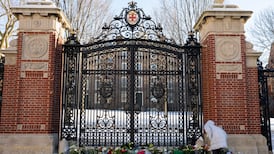The highest resolution image of the deepest part of the universe ever seen has been released by the US space agency Nasa.
At a ceremony in the White House on Monday US president Joe Biden and senior Nasa leaders unveiled the first picture from the new $10 billion James Webb space telescope.
Nasa administrator Bill Nelson said the image showed light from galaxies which had been travelling for 13 billion years.
“You’re seeing galaxies that are shining around other galaxies whose light has been bent, and you’re seeing just a small, little portion of universe.
READ MORE
“One hundred years ago we thought there was only one galaxy, now the number is unlimited.
“We are looking back more than 13 billions years. Light travels at 186,000 miles per second. The light you are seeing on one of those little specks has been travelling for over 13 billion. And we are going back further. This is just the first image. They are going back 13.5 billion years. Since we know the universe is 13.8 billion years old, we are going back almost to the beginning.”
Further pictures taken by the Webb telescope will be released by Nasa on Tuesday.
Mr Nelson said the telescope was so precise it would also allow scientists to determine whether planets were habitable by looking at the chemical composition of their atmospheres.
Mr Biden said the release of the first image represented “a historic day”.
He said it would remind the world that “American can do big things and remind children that nothing is beyond their capacity”.
The Webb telescope was launched in December and has spent more than six months travelling to its new orbit which is about one million miles from Earth.
The size of a tennis court and three storeys high, Webb is the largest telescope ever sent into space.
It is about 100 times more powerful than the Hubble telescope, which was has been taking images of the universe for over 30 years.
The Webb telescope is based at what is known as the second Lagrange point, or L2, much further away from Earth than Hubble.
At L2, the gravitational influence of the sun and the Earth keep the Webb telescope’s motion around the sun in synchronisation with that of the Earth.
The Webb Space Telescope is an international programme led by Nasa with its partners, the European Space Agency and the Canadian Space Agency.
The White House said the revolutionary technology of the Webb telescope “will study every phase of cosmic history over the past 13.5 billion years — from inside our solar system to the most distant observable galaxies in the early universe”
“The telescope gives us the capacity to explore a wide range of questions that help us understand the origins of the universe and our place within it. The telescope is one of humanity’s great engineering feats, launching from Earth on a rocket, and then unfolding itself in space. Thousands of engineers and hundreds of scientists worked to make the telescope a reality, along with over 300 universities, organisations, and companies from 29 US states and 14 countries.”
.
















